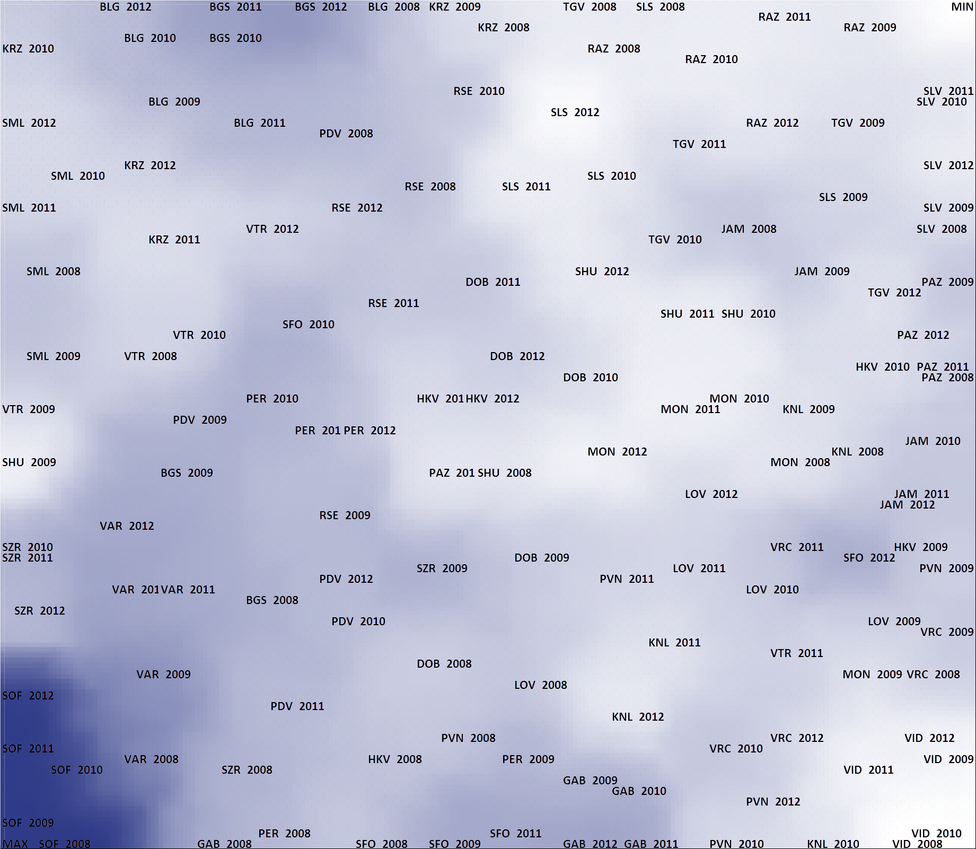Economy
Information
This map shows the economic condition and development of all districts during the 2008-2012 period. The dark color in the bottom left corner of the map, where Sofia (cap) is located, indicates this districts superior economic development in comparison to the other districts. The color is much richer even when compared to the districts closest to Sofia (cap) – Varna and Plovdiv. The development of Varna shows negative, though quite subtle, tendencies. Similar trends are observed in the district of Plovdiv.
The districts Silistra, Montana and Vidin are the worst developed, as indicated by the light color of the zone of the map, in which they are situated.
During the entire period the district of Vidin shows weak development tendencies, as can be seen by the lack of difference in the saturation. Similar trends are visible in Razgrad and Silistra.
During the last 3 years of the period, negative trend are also visible in the districts Shumen and Montana.

Methodology
The multidimensional analysis of regional development analyzes the overall socio-economic development of Bulgarian districts in the 2008-2012 period, using a wide variety of indicators, grouped in seven categories: economy, infrastructure, demographics, education, healthcare, environment, social environment. The method chosen to achieve this is neural networks – Cohonen Self-Organizing Maps (SOM), to be precise.
Two “fake regions” have been established for the purpose of this analysis. One is a “perfect” region, which scores best (has the highest marks) on all indicators at the same time. The other one is a “worst” region, which scores worst (has the lowest marks). These “fake regions” are used as reference points and benchmarks for assessing the development of the 28 regions during this period. The current state and development of all 28 regions is assessed as positive or negative in comparison to these benchmarks.
One should note that on the maps of the different categories the best-developed territory does not necessarily coincide with the “perfect region”, neither the worst-developed territory coincides with the “worst region”. This happens because the “best” and the “worst” region are defined as such on the basis of all categories at the same time and are therefore fake and do not really exist. Empirical data shows that some regions score high in some categories and low in others.
After the analysis, the districts have been grouped into clusters, formed by Cohonen’s self-organizing maps. The results are represented by two separate methods:
- The clusters are presented through the so-called “unified distance matrix” (U-matrix). The dark zones represent the borders of the clusters, the light ones – the clusters themselves. The darker the border between the clusters, the more they differ from each other and vice versa.
- Each zone on the Cohonen map is characterized by a certain level of development, achieved during the period (low or high) based on the different categories – from economy to social environment. The rankings in the different categories are also represented visually on the different maps, with the more saturated color representing high ranking, while a less saturated – low ranking.
If a region ranks “best” in each of the categories – from economy to social environment, it should match the “perfect” one or be very close to it. In reality, none such exists, so the regions are located all over the map. The reasons for their location can be seen in the analysis of the different categories.
The results thus represented in the Cohonen maps allow us to study the development of all regions for the entire period at the same time, visualizing:
- Difference levels – how much do certain regions differ from the others during one or all years of the period;
- Development directions – whether the development of the regions shows a positive or a negative trend;
- Speed of development – what is the pace of growth or decline;
- Development trajectoryis the re cohesion between the regions, or – even better – an approach towards the “perfect region”.
Legend
| Code | Name |
|---|---|
| BGS | Burgas |
| BLG | Blagoevgrad |
| DOB | Dobrich |
| GAB | Gabrovo |
| HKV | Haskovo |
| JAM | Yambol |
| KNL | Kyustendil |
| KRZ | Kardzali |
| LOV | Lovech |
| MON | Montana |
| PAZ | Pazardzhik |
| PDV | Plovdiv |
| PER | Pernik |
| PVN | Pleven |
| RAZ | Razgrad |
| RSE | Ruse |
| SFO | Sofia |
| SHU | Shumen |
| SLS | Silistra |
| SLV | Sliven |
| SML | Smolyan |
| SOF | Sofia (capitol) |
| SZR | Stara Zagora |
| TGV | Targovishte |
| VAR | Varna |
| VID | Vidin |
| VRC | Vratsa |
| VTR | Veliko Tarnovo |
| MAX | „Идеална област“ |
| MIN | „Най-слаба област“ |
Latest news
Math talents on the edge of the map 30.06.2025
If you think that mathematics can only be taught and learned well in mathematics high schools or elite...
The municipalities need more own resources and a share of revenues from personal income taxation 26.06.2025
IME analysis shows opportunities for expanding municipalities' financial autonomy. The budget expenditures...
Gross domestic product, incomes and pensions in Yambol district continue to grow. The share of the working...